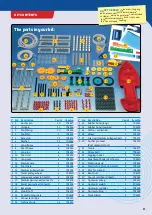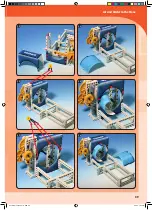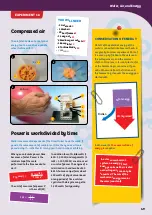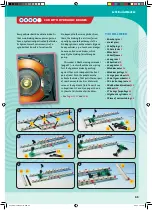
1
2
3
8 x
23
17
19
6
5
11
8
17
49
Compressed air
EXPERIMENT 18
YOU WILL NEED
›
1 Axle lock
5
›
1 Washer
6
›
2 Short frames
8
›
1 Long axle
11
›
2 Medium gear wheels
17
›
1 Baseplate
19
›
8 Turbine blades
23
› 1 Balloon
The air-filled balloon has potential
energy too. You can drive a paddle
wheel turbine with it.
CONSERVATION OF ENERGY
Not all of the potential energy of the
water is converted into hammer beats in
our gravity hammer experiment. Part of
it is used up by friction in the axle seats,
the pulley wheels, and the hammer
shaft. In this process, it is only lost as far
as the hammering is concerned. If you
add up the work from the friction and
the hammering, it equals the energy you
started with.
In other words,
the conservation of
energy law
applies:
Total energy
Work yielded
Friction
Slip-
stream
Turbulence
Panel
Cylinder
Teardrop
Turbulence
Toggle switch center
Stop in all directions
Supply
Toggle switch
left
Toggle switch
right
Total Pressure
Dynamic
Pressure
Static Pressure
F1
F2
F2
L1
L2
F1
L1
L2
One-armed
lever
Two-armed
lever
Lift
Aileron
(wing flap)
Rudder
Pitch elevator
Horizontal stabilizer
Stagnation point
Lift through low pressure on the
upper side of the wing
Vertical stabilizer
(vertical tailfin)
Wing
Aileron (wing flap)
Gravity
Wing
Center of
mass
Center of lift
Stagnation point while gliding
A1
V1
V2
Equal quantities of water
A2
H1
H2
Buoyancy B =
Hydrostatic pressure 1 –
Hydrostatic pressure 2
B
Stagnation point
Lift through low pressure on the
upper side of the wing
Additional lift through pressure
on the underside
Pressure on the underside
Balloon
In a closed mechanical
system, no energy is lost.
Energy can be neither created
nor destroyed. It can only be
converted. The sum of the
mechanical energy remains
the same (constant).
When you calculate power, time
becomes a factor. Power is the
relationship of the work
performed to the time needed to
do it:
In addition to watts, kilowatts (1
kW = 1,000 W) and megawatts (1
mW = 1,000,000 W) are also used
as units of power. The engine of a
mid-sized car handles about 60
kW. A human can perform about
200 watts of physical work over
a long period of time, while a
cyclist with a bicycle can get to
1,500 watts fairly quickly.
Work is measured independent of the time it takes to do the work. If
you do the same amount of work in less time, then you exert more
power doing it — whether its raising your hand in school or biking.
Power is work divided by time
1 N =
1 kg · m
s
2
1 Pa =
1 bar = 1,000 hPa
1 N
1 m
2
1 W =
1 J
1 s
P (Pressure) =
F
1
: A
1
= F
2
: A
2
p
1
: p
2
= V
2
: V
1
p
1
: p
2
= T
1
: T
2
or: p · V = constant
(only valid when T = c
onstant)
F
1
· L
1
= F
2
· L
2
p
1
· V
1
= p
2
· V
2
A
1
· v
1
= A
2
· v
2
Load · Load arm =
Force · Force arm
F ( Force)
A (Area)
P (power) =
W (work) = F (force) · s (dist
ance)
W (work)
t (time)
Fd = Cd ·
A · · v
2
2
P =
= 2
= 2 Pa
10 N
5 m
2
N
m
2
P =
= 200,000 Pa
100 N
0.0005 m
2
P =
= 16,000 Pa or 16 hP
a or 1.6 bar
4 N
0.00025 m
2
or
= constant
=
p
1
· V
1
T
1
p · V
T
p
2
· V
2
T
2
Fd = 0.4 ·
2 m
2
· 1.23 kg/m
3
· (40 m/s)
2
2
Fd = 0.4 ·
= 787.2 N
3936
2
kg · m
s
2
1 N = 1 kg · m
s
2
1 Pa =
1 bar = 1,000 hPa
1 N
1 m
2
1 W =
1 J
1 s
P (Pressure) =
F
1
: A
1
= F
2
: A
2
p
1
: p
2
= V
2
: V
1
p
1
: p
2
= T
1
: T
2
or: p · V = constant
(only valid when T = c
onstant)
F
1
· L
1
= F
2
· L
2
p
1
· V
1
= p
2
· V
2
A
1
· v
1
= A
2
· v
2
Load · Load arm = Force · Force arm
F ( Force)
A (Area)
P (power) =
W (work) = F (force) · s (dist
ance)
W (work)
t (time)
Fd = Cd · A · · v
2
2
P =
= 2
= 2 Pa
10 N
5 m
2
N
m
2
P =
= 200,000 Pa
100 N
0.0005 m
2
P =
= 16,000 Pa or 16 hPa or 1.6 bar
4 N
0.00025 m
2
or
= constant
=
p
1
· V
1
T
1
p · V
T
p
2
· V
2
T
2
Fd = 0.4 · 2 m
2
· 1.23 kg/m
3
· (40 m/s)
2
2
Fd = 0.4 ·
= 787.2 N
3936
2
kg · m
s
2
The unit of measure for power P
is the watt (W):
Water, Air, and Energy








